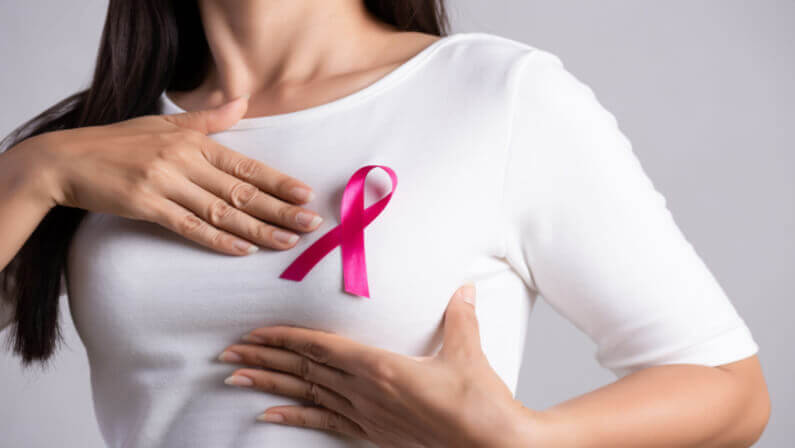Breast cancer is the most common type of cancer in women and the second leading cause of cancer death in women. Though there is no sure way to prevent breast cancer, there are things you can do to reduce your risk.
With October fast approaching, Breast Cancer Awareness Month, we want to share with you some information on breast cancer, its causes, how to prevent it, and everything about it.
What is breast cancer?
Breast cancer is a type of cancer that forms in the tissues of the breast. The most common type of breast cancer is ductal carcinoma, which begins in the lining of the milk ducts, and Invasive ductal carcinoma, which forms in the cells lining the milk ducts and then invades nearby healthy breast tissue.
Who gets breast cancer?

Most breast cancer cases are diagnosed in women who are 50 years old or older, though breast cancer can occur at any age. The chance of getting breast cancer increases as you age.
Other risk factors for developing breast cancer include:
- A personal history of breast cancer
- Dense, fibrous breasts
- A family history of breast cancer (especially in a mother, sister, or daughter)
- Early onset menstruation
- Late menopause
- Radiation exposure
- Obesity
What are the types of breast cancer?
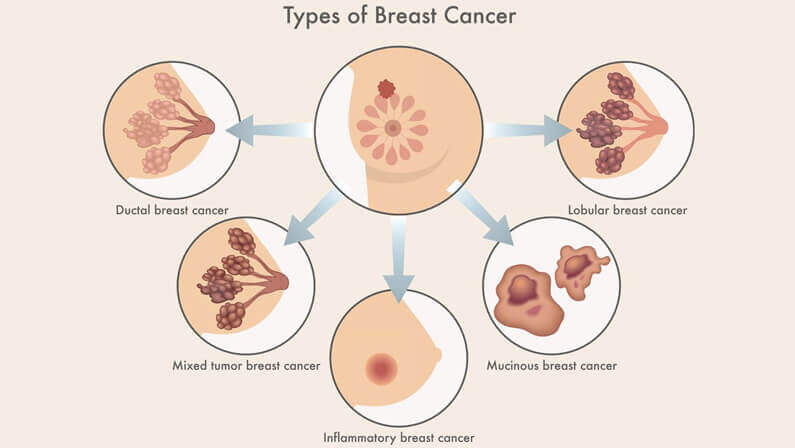
There are different types of breast cancer, namely:
Infiltrating (invasive) ductal carcinoma
Invasive (infiltrating) ductal carcinoma is the most common type of breast cancer. About 80% of all breast cancers are invasive ductal carcinomas.
This type of breast cancer starts in the milk ducts, but then breaks through the wall of the duct and invades other tissues in the breast. Invasive ductal carcinoma can spread to any part of the body, but most often spreads to the lymph nodes under the arm or around the collarbone.
Invasive ductal carcinoma is sometimes called infiltrating ductal carcinoma or IDC. The signs of invasive ductal carcinoma are the same as the signs of any other type of breast cancer.
The stage of invasive ductal carcinoma is described using the TNM staging system. See the Stages of breast cancer section for more information.
Treatment for invasive ductal carcinoma usually involves surgery, radiation therapy, chemotherapy, hormone therapy, or a combination of these treatments.
Ductal carcinoma in situ
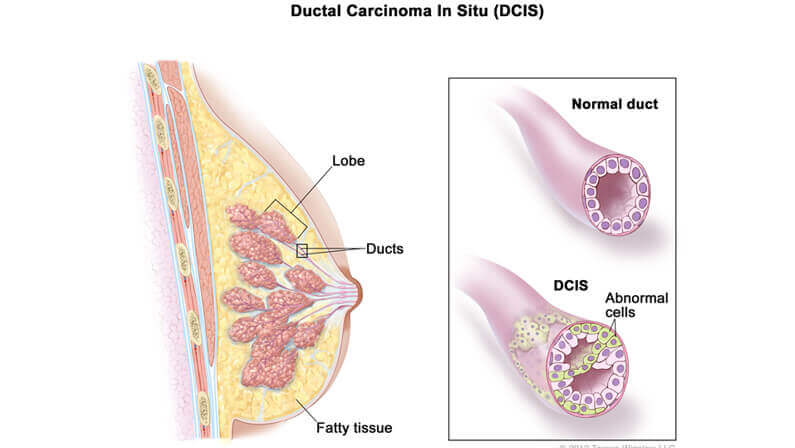
Ductal carcinoma in situ (DCIS) is non-invasive breast cancer. DCIS is considered Stage 0 breast cancer because it has not spread outside of the milk ducts into the surrounding breast tissue. In most cases, DCIS can be treated successfully with surgery and/or radiation therapy.
DCIS is sometimes called intraductal carcinoma. It is the most common type of non-invasive breast cancer diagnosed in women today. About 1 out of every 5 new breast cancer diagnoses in the United States is DCIS.
While DCIS is not life-threatening, some types have a higher risk of coming back (recurrence) after treatment and turning into invasive breast cancer that can spread to other parts of the body. This is why knowing your DCIS grade is important.
Infiltrating (invasive) lobular carcinoma
Invasive lobular carcinoma (ILC) is the second most common type of invasive breast cancer, accounting for about 10% to 15% of all breast cancers. 3 ILC starts in the milk-producing glands (lobules) of the breast. From there, it can invade nearby normal breast tissue. ILC can also spread to any part of the body, but most often spreads to lymph nodes under the arm or around the collarbone.
Treatment for invasive lobular carcinoma usually involves surgery, radiation therapy, chemotherapy, hormone therapy, or a combination of all types.
Lobular carcinoma in situ
Lobular carcinoma in situ (LCIS) is non-invasive breast cancer. LCIS is considered Stage 0 breast cancer because it does not spread outside of the milk glands. LCIS is usually found during a breast biopsy for another reason.
LCIS is not life-threatening, but having LCIS increases your risk of developing invasive breast cancer in either breast at some point in your life. For this reason, women with LCIS often have frequent breast cancer screenings.
Treatment for LCIS may include close monitoring, hormone therapy, or both. A small number of women with LCIS may opt to have a prophylactic mastectomy (removal of the breast).
Triple-negative breast cancer
Triple-negative breast cancer (TNBC) is a type of invasive breast cancer that does not have receptors for estrogen, progesterone, or HER2. TNBC accounts for about 15% to 20% of all breast cancers
Treatment for triple-negative breast cancer usually involves surgery, radiation therapy, chemotherapy, or a combination of these treatments.
Inflammatory breast cancer
Inflammatory breast cancer (IBC) is a rare and aggressive type of breast cancer. IBC accounts for 1% to 5% of all breast cancers.5
The signs of IBC are different from the signs of other types of breast cancer. The most common sign of IBC is redness and swelling of the breast, which can happen quickly, over a period of weeks or months. Other signs include itching, warmth, and pain in the breast; nipple changes; enlarged lymph nodes under the arm or around the collarbone; and an orange-peel-like texture to the skin of the breast (called peau d’orange).
Paget’s disease of the breast
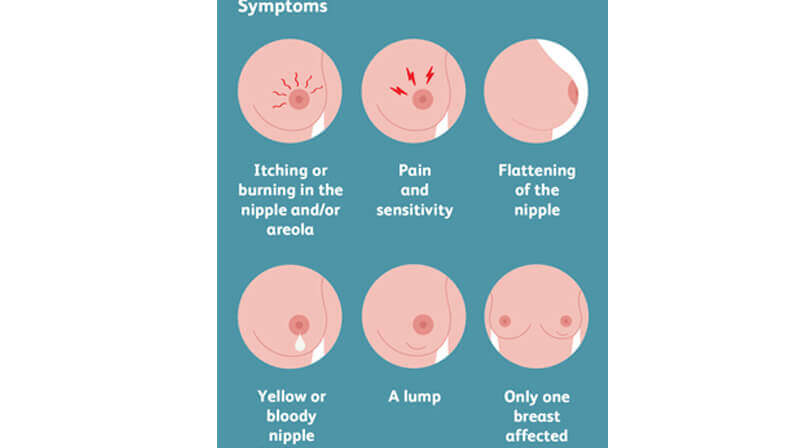
Paget’s disease of the breast is a rare type of breast cancer that starts in the nipple. Paget’s disease accounts for 1% to 4% of all breast cancers.6
The most common sign of Paget’s disease is a change in the appearance of the nipple, such as crusting, scaling, or ulceration. Other signs include itching, burning, pain, or discharge from the nipple; changes to the skin of the nipple and areola (the dark area around the nipple); and enlargement or lump in the breast.
Treatment for Paget’s disease usually involves surgery, radiation therapy, chemotherapy, or a combination of these treatments.
What causes breast cancer?
There are several causes of breast cancer, such as:
- Heredity
- Family health history
- Hormones
- Diet
- Alcohol use
- Smoking
- Radiation exposure
- Previous breast cancer or ductal carcinoma in situ
Breast Cancer Symptoms
While most breast cancers are found through screening mammograms, some women — especially those with denser breast tissue — may develop symptoms of breast cancer that prompt them to see their doctor.
Some symptoms are:
- A new lump in the breast or underarm (armpit).
- Swelling of all or part of the breast.
- Skin irritation or dimpling.
- Breast pain.
- Nipple pain or the nipple turning inward.
- Redness, scaliness, or thickening of the nipple or breast skin.
- Nipple discharge other than breast milk, including blood.
- Any change in the size or shape of the breast.
Keep in mind that these symptoms may also be signs of conditions other than cancer, such as an infection or a cyst. If you have any of these symptoms, see your doctor right away so that any problems can be diagnosed and treated as early as possible.
Breast Cancer Diagnosis
Once diagnosed with breast cancer, your doctor will work with you to develop a treatment plan that is best for you.
Treatment plans are based on the type of breast cancer, its stage, grade, and hormone receptor status, as well as your age, overall health, and personal preferences.
What are the stages of breast cancer?
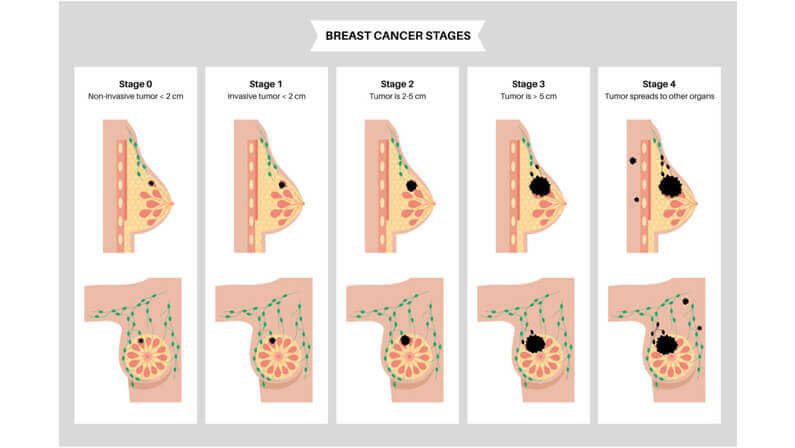
The stage of breast cancer is a way of describing how far cancer has spread in the body. It is one of the most important factors in determining your prognosis (outlook) and choosing the best treatment for you.
There are four main stages of breast cancer:
- Stage 0
- Stage I
- Stage II
- Stage III
- Recurrent
In addition to the main stages, breast cancers may also be described as in situ or invasive. In situ means that the cancer is still within its original location and has not spread to surrounding tissues. Invasive means that cancer has spread from where it started into nearby tissues.
Breast Cancer Risk Factors
When you have breast cancer, such risk factors can be expected:
- Age. The risk of breast cancer increases with age, especially after menopause.
- Genetics. Having a family member with breast cancer, particularly a first-degree relative (mother, daughter, or sister), raises your risk.
- History of breast cancer or breast lumps. If you have had breast cancer in one breast, you’re at an increased risk of developing cancer in the other breast.
- Dense breast tissue. Dense breast tissue is normal which means you have more connective tissue and less fatty tissue. Dense breast tissue can make it harder to detect breast cancer on a mammogram.
- Estrogen exposure or breastfeeding history. Exposure to estrogen — either through taking hormone replacement therapy or having your first period before age 12 — can increase your risk of breast cancer.
- Body weight. Being overweight or obese increases your risk of postmenopausal breast cancer.
- Alcohol consumption. Drinking alcohol is linked to an increased risk of developing breast cancer.
- Radiation exposure. Radiation therapy for other cancers, such as Hodgkin’s disease, can raise your risk of developing breast cancer.
- Hormone treatments. Treatment with the hormone progesterone, as well as some forms of birth control pills, can slightly increase your risk of breast cancer.
- Race. White women are more likely to develop breast cancer than African-American women. But African-American women are more likely to die of the disease.
- Cosmetic implants and breast cancer survival. There is no link between cosmetic implants and an increased risk of developing breast cancer. However, if you have implants, it may be harder to detect some problems.
Breast Cancer Treatments
There are several treatment types to treat breast cancer, such as:
Breast cancer surgery
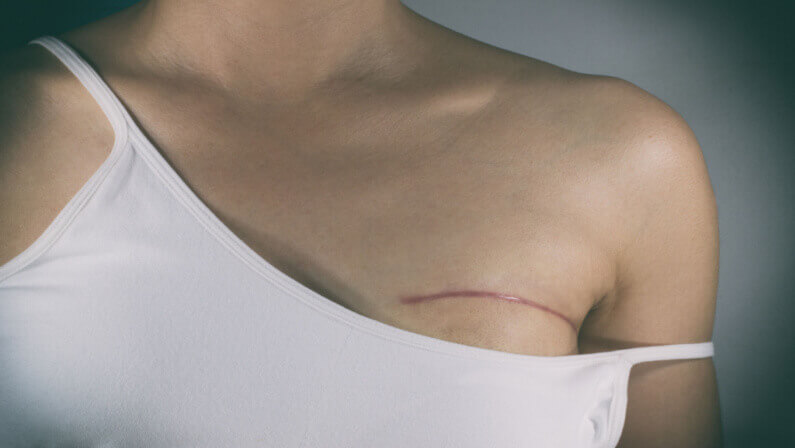
Surgery is the most common treatment for breast cancer. The type of surgery depends on the stage and type of breast cancer, as well as your age, menopausal status, and overall health history.
Chemotherapy
Chemotherapy is often used in addition to surgery for breast cancer. It may also be used as the only treatment for certain types of breast cancer.
Radiation therapy
Radiation therapy uses high-energy beams to kill cancer cells. It is often used in addition to surgery for breast cancer.
Hormone Therapy
This is a treatment that lowers the number of hormones in your body. This can slow or stop the growth of hormone-receptor-positive breast cancers.
Targeted Therapy
This type of treatment targets specific genes or proteins in cancer cells. It is often used in addition to other treatments, such as chemotherapy or hormone therapy.
Immunotherapy
Immunotherapy is a type of treatment that helps your immune system fight cancer. It is often used in addition to other treatments, such as chemotherapy.
How to Reduce the Risk of Breast Cancer
To reduce the risk of breast cancer, here are some things you can do:
- Limit alcohol. Alcohol should be limited to no more than one drink per day for women.
- Maintain a healthy weight. Being overweight or obese can increase your risk of breast cancer, especially after menopause.
- Exercise regularly. Moderate to vigorous exercise for at least 30 minutes on most days can help you maintain a healthy weight and lower your risk of breast cancer.
- Eat less meat. Eating a diet high in meat and processed food can increase your risk of breast cancer.
- Eat more vegetables and fruits. A diet rich in vegetables and fruits may protect against breast cancer.
- Breastfeed your baby. Breastfeeding can lower your risk of breast cancer.
- Limit your exposure to postmenopausal hormone therapy. Exposure to estrogen — either through taking hormone replacement therapy or having your first period before age 12 — can increase your risk of breast cancer.
- Don’t smoke. Smoking can increase your risk of breast cancer.
- Avoid Birth Control Pills, Particularly After Age 35 or If You Smoke. Treatment with the hormone progesterone, as well as some forms of birth control pills, can slightly increase your risk of breast cancer.
- Tamoxifen and Raloxifene for Women at High Risk of Breast Cancer. If you’re at high risk of breast cancer, taking the drugs tamoxifen or raloxifene can help lower your risk.
- Know your family history. If you have a family history of breast cancer, you may be at higher risk. Talk to your doctor about what this means for
Talk to Your Doctor About Breast Cancer Risk Factors
If you have any questions or concerns about your risk of breast cancer, talk to a professional. We at Aether Health – Kingwood ER & Medical Clinic are here to help you with your health needs! Visit our website or give us a call today.

